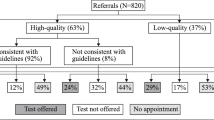Abstract
The introduction of screening for multiple high and moderate risk mutations in genes has resulted in a complex approach to patient care involving multiple disciplines. We sought to describe the feasibility of a single visit multidisciplinary approach to the management of patients with an identified high/moderate risk gene mutation. Patients who presented to our community hospital over a 1-year period who were found to have a high/moderate risk genetic mutation on a screening panel were referred to the High Risk Genetic Clinic. Thirty-five patients were included. The majority were female [34 (97.1%)], Hispanic [22 (62.9%)], with a family history of cancer [21 (60%)]. Mean age was 40.3 years. Most of the participants had a BRCA1 gene mutation [10 (28.6%)]. Patients were seen at the High Risk Genetic Clinic within a mean of 41.9 days from the day of genetic mutation diagnosis. Four patients did not show and were significantly younger (19.3 vs. 39.6 years, p = 0.014). In this community setting, we provided coordinated care within multiple disciplines related to a genetic mutation in a single clinic visit. Increased efforts at coordinating early care should be directed towards patients diagnosed at a younger age.
Similar content being viewed by others
References
Rahman N (2014) Realizing the promise of cancer predisposition genes. Nature 505:302–308
Domchek SM, Bradbury A, Garber JE, Offit K, Robson ME (2013) Multiplex genetic testing for cancer susceptibility: out on the high wire without a net? J Clin Oncol 31:1267–1270
Turnbull C, Rahman N (2008) Genetic predisposition to breast cancer: past, present, and future. Annu Rev Genomics Hum Genet 9:321–345
National Comprehensive Cancer Network (2016) Breast Cancer 1.2016. http://www.nccn.org. Accessed Mar 2016
Antoniou AC, Casadei S, Heikkinen T et al (2014) Breast-cancer risk in families with mutations in PALB2. N Engl J Med 371:497–506
Hofstatter EW, Domchek SM, Miron A, Garber J, Wang M, Componeschi K, Boghossian L, Miron PL, Nathanson KL, Tung N (2011) PALB2 mutations in familial breast and pancreatic cancer. Fam Cancer 10:225–231
Verna EC, Hwang C, Stevens PD et al (2010) Pancreatic cancer screening in a prospective cohort of high-risk patients: a comprehensive strategy of imaging and genetics. Clin Cancer Res 16:5028–5037
Easton DF, Pharoah PDP, Antoniou AC et al (2015) Gene-panel sequencing and the prediction of breast-cancer risk. N Engl J Med 372:2243–2257
NCCN Practical Guidelines in Oncology (NCCN Guidelines) (2017) Genetic/familial high-risk assessment: breast and ovarian. Version 2.2017. http://www.nccn.org. Accessed Feb 2017
Author information
Authors and Affiliations
Corresponding author
Rights and permissions
About this article
Cite this article
O’Leary, M.P., Goldner, B.S., Abboy, S. et al. A single visit multidisciplinary model for managing patients with mutations in moderate and high-risk genes in a community practice setting. Familial Cancer 17, 175–178 (2018). https://doi.org/10.1007/s10689-017-0010-1
Published:
Issue Date:
DOI: https://doi.org/10.1007/s10689-017-0010-1



